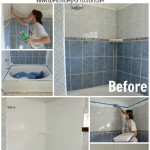Ideas for Bridging the Gap Between Bathroom Vanity and Wall Unit
The efficient use of space is paramount in bathroom design, especially in smaller bathrooms where every inch counts. One common challenge faced during bathroom renovations or new builds is the presence of a gap between the bathroom vanity and the adjacent wall unit or wall. This gap, often resulting from slight dimensional discrepancies, structural irregularities, or design choices, can become a source of aesthetic dissatisfaction and practical inconvenience. It can accumulate dust, debris, and moisture, potentially leading to mold growth and damage to the surrounding structures. Moreover, an unsightly gap detracts from the overall visual appeal of the bathroom.
Addressing this issue requires creative solutions that are both functional and visually harmonious. Several approaches can be employed, ranging from simple fillers and sealants to more elaborate custom-built additions. The chosen method will typically depend on the size of the gap, the style of the bathroom, the budget, and the desired level of permanence. This article explores various ideas for filling the gap between a bathroom vanity and a wall unit, providing insights into their advantages, disadvantages, and implementation considerations.
Employing Fillers and Sealants for Minor Gaps
For smaller gaps, typically less than an inch, fillers and sealants offer a straightforward and cost-effective solution. These materials are designed to close the space, prevent moisture intrusion, and create a seamless appearance. The selection of the appropriate filler or sealant is crucial for achieving optimal results.
Caulk, a flexible sealant available in various colors and formulations, is a common choice. Silicone caulk is particularly suitable for bathrooms due to its excellent water resistance and ability to withstand temperature fluctuations. Acrylic caulk is another option, offering good paintability, allowing it to blend seamlessly with the surrounding surfaces. However, acrylic caulk is generally less flexible than silicone and may be more prone to cracking over time. When applying caulk, it is essential to thoroughly clean and dry the surfaces to ensure proper adhesion. A caulk gun is typically used to apply the sealant evenly, and a smoothing tool can be employed to create a clean, professional finish.
Expanding foam can also be used as a filler for larger gaps before applying a sealant. This material expands to fill the space, providing insulation and a solid backing for the sealant. However, it should be used sparingly and carefully, as excessive expansion can damage the surrounding surfaces. Once the foam has cured, it can be trimmed and sanded to create a smooth surface before applying caulk or other sealant.
Another option is using wood filler, especially if the vanity and wall unit are made of wood or have a wood-like finish. Wood filler can be applied to the gap and then sanded to match the surrounding surfaces. Once sanded smooth, the filled area can be stained or painted to seamlessly integrate with the existing finish. This approach requires careful color matching and blending to achieve a visually consistent result.
The advantage of using fillers and sealants lies in their simplicity and affordability. They are relatively easy to apply and require minimal tools or expertise. However, these solutions are primarily suitable for small gaps. For larger gaps, they may not provide sufficient structural support or aesthetic appeal.
Installing a Custom-Built Filler Piece
When dealing with larger or more irregular gaps, a custom-built filler piece offers a more robust and visually appealing solution. This approach involves creating a piece of material, typically wood or a similar composite, that perfectly fits the space between the vanity and the wall unit. The filler piece can be designed to match the style and finish of the surrounding furniture, creating a seamless and integrated appearance.
The process begins with accurately measuring the dimensions of the gap. It is crucial to account for any irregularities or variations in width along the length of the gap. A template can be created using cardboard or paper to ensure a precise fit. Once the measurements are obtained, a piece of wood or other suitable material can be cut to the required size and shape.
The choice of material will depend on the style of the bathroom and the existing furniture. Solid wood offers a classic and durable option, while MDF (Medium Density Fiberboard) provides a more affordable and versatile alternative. MDF is easy to cut and shape, and it can be painted or veneered to match the surrounding surfaces. Other options include PVC boards, which are water-resistant and ideal for humid environments.
After cutting the filler piece, it can be finished to match the vanity and wall unit. This may involve staining, painting, or applying a veneer. It is essential to use high-quality finishes that are resistant to moisture and wear. The filler piece can be attached to the vanity or the wall unit using screws, nails, or adhesive. It is important to ensure that the attachment is secure and stable. A bead of caulk can be applied along the edges of the filler piece to seal the gap and prevent moisture intrusion.
The advantage of using a custom-built filler piece is that it provides a tailored solution that perfectly addresses the specific characteristics of the gap. It can be designed to seamlessly integrate with the existing furniture, creating a cohesive and visually appealing result. However, this approach requires more time, skill, and resources than using fillers and sealants. It may also require the assistance of a professional carpenter or contractor.
Introducing Decorative Elements to Conceal the Gap
Beyond simply filling the gap, another approach involves incorporating decorative elements that visually minimize or conceal the space. This method focuses on drawing attention away from the gap and integrating it into the overall design of the bathroom. Several decorative elements can be used to achieve this effect.
A narrow shelf, installed between the vanity and the wall unit, can serve as both a functional and decorative element. The shelf can be used to display small items, such as toiletries, decorative objects, or plants. The presence of the shelf distracts from the gap and adds visual interest to the space. The shelf can be made of wood, glass, or metal, depending on the style of the bathroom.
Another option is to install a vertical strip of decorative tile or stone. This strip can be used to create a visual break between the vanity and the wall unit, effectively concealing the gap. The tile or stone can be chosen to complement the existing bathroom décor, adding texture and color to the space. The vertical strip can also be used to highlight a particular feature of the bathroom, such as a mirror or a piece of artwork.
Adding a small, freestanding storage unit, like a narrow cabinet or a set of drawers, can also effectively fill the gap and provide additional storage space. The storage unit can be chosen to match the style and finish of the vanity and wall unit, creating a cohesive look. The storage unit can be used to store towels, toiletries, or other bathroom necessities.
Furthermore, using a strategically placed mirror can create an illusion of continuity and minimize the appearance of the gap. A mirror that extends across the vanity and onto the adjacent wall can visually connect the two elements, making the gap less noticeable. The mirror can also enhance the sense of space and light in the bathroom.
The advantage of using decorative elements is that it allows for a more creative and personalized approach to addressing the gap. It can add visual interest and functionality to the bathroom, while effectively concealing the space. However, this approach requires careful planning and coordination to ensure that the decorative elements complement the existing décor and achieve the desired effect.
Ultimately, the optimal solution for bridging the gap between a bathroom vanity and a wall unit will depend on a variety of factors, including the size and nature of the gap, the style of the bathroom, the budget, and the desired level of permanence. By carefully considering the available options and their respective advantages and disadvantages, homeowners can choose the approach that best suits their needs and preferences, creating a functional and visually appealing bathroom space.

Vanity Wall Gap Filler

Alcove Vanity Flush To Walls Or Ok Have Space On Sides

How To Fill A Gap Between Vanity And Side Wall Baseboard Issue Too

Filling The Space Between Your Bathroom Cabinet And Wall Tapron

The Question Of Vanity View Along Way

Nice Little Shelves To Fill The Gap Between Vanity And Wall In Small Bathroom

Big Gap Between Vanity And Wall

The Question Of Vanity View Along Way

Gap Between Bathroom Vanity And Wall How To Fill It Like A Pro Glamorous Place

Gap Between Vanity And Wall
Related Posts







